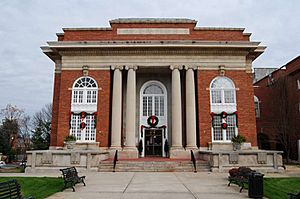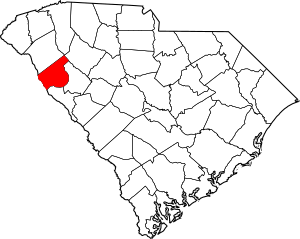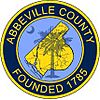Abbeville County, South Carolina facts for kids
Quick facts for kids
Abbeville County
|
||
|---|---|---|

|
||
|
||
| Motto(s):
"A Great Place to Live."
|
||

Location within the U.S. state of South Carolina
|
||
 South Carolina's location within the U.S. |
||
| Country | ||
| State | ||
| Founded | 1785 | |
| Named for | Abbeville, France | |
| Seat | Abbeville | |
| Largest community | Abbeville | |
| Area | ||
| • Total | 511.74 sq mi (1,325.4 km2) | |
| • Land | 491.19 sq mi (1,272.2 km2) | |
| • Water | 20.55 sq mi (53.2 km2) 4.02% | |
| Population
(2020)
|
||
| • Total | 24,295 | |
| • Estimate
(2023)
|
24,434 | |
| • Density | 49.46/sq mi (19.10/km2) | |
| Time zone | UTC−5 (Eastern) | |
| • Summer (DST) | UTC−4 (EDT) | |
| Congressional district | 3rd | |
Abbeville County is a county located in the U.S. state of South Carolina. As of the 2020 census, its population was 24,295. Its county seat is Abbeville. It is the first county (or county equivalent) in the United States alphabetically. Abbeville County included in the Greenville-Spartanburg-Anderson, SC Combined Statistical Area, known colloquially as the Upstate or the Upcountry.
History
Both Abbeville County and the county seat, Abbeville, get their name from the town of Abbeville, France, the native home of an early settler. The county was originally part of Ninety-Six District, South Carolina, but was designated Abbeville County in 1785, with parts of the county later going to the creation of the counties of Greenwood and McCormick. Abbeville County was settled by mostly Scotch Irish and French-Huguenot farmers in the mid-18th century.
The Treaty of Dewitt's Corner, a historic peace negotiation with the Cherokee Indians, was signed in Dewitt's Corner (which is now known as Due West) in the county. As a result of the treaty, the Cherokee tribe broke into two factions, one of which, the Chickamauga Cherokee, continued fighting area settlers for another 30 years.
Abbeville County was a hotbed of secession before the Civil War and was also where the last Confederate council of war was held.
In 1950 Abbeville County had a population of 22,456. As of the 2020 census, this has grown to 24,295 people.
Geography
According to the U.S. Census Bureau, the county has a total area of 511.74 square miles (1,325.4 km2), of which 491.19 square miles (1,272.2 km2) is land and 20.55 square miles (53.2 km2) (4.02%) is water. Abbeville County is in the Savannah River basin and the Saluda River basin.
National protected area
- Sumter National Forest (part)
State and local protected areas/sites
- Calhoun Falls State Park
- Cedar Springs Historic District
- Long Cane Scenic Area
- McCalla Wildlife Management Area
Major water bodies
Adjacent counties
- Greenville County – north
- Anderson County – north
- Laurens County – northeast
- Greenwood County – east
- McCormick County – southeast
- Elbert County, Georgia – west
Major highways

 US 25 Bus.
US 25 Bus. US 178
US 178 SC 20
SC 20


 SC 20 Conn.
SC 20 Conn. SC 28
SC 28


 SC 28 Conn.
SC 28 Conn. SC 71
SC 71


 SC 71 Truck
SC 71 Truck SC 72
SC 72 SC 81
SC 81 SC 184
SC 184 SC 185
SC 185 SC 203
SC 203


 SC 203 Truck
SC 203 Truck SC 284
SC 284
Demographics
| Historical population | |||
|---|---|---|---|
| Census | Pop. | %± | |
| 1790 | 9,197 | — | |
| 1800 | 13,553 | 47.4% | |
| 1810 | 21,156 | 56.1% | |
| 1820 | 23,167 | 9.5% | |
| 1830 | 28,149 | 21.5% | |
| 1840 | 29,351 | 4.3% | |
| 1850 | 32,318 | 10.1% | |
| 1860 | 32,385 | 0.2% | |
| 1870 | 31,129 | −3.9% | |
| 1880 | 40,815 | 31.1% | |
| 1890 | 46,854 | 14.8% | |
| 1900 | 33,400 | −28.7% | |
| 1910 | 34,804 | 4.2% | |
| 1920 | 27,139 | −22.0% | |
| 1930 | 23,323 | −14.1% | |
| 1940 | 22,931 | −1.7% | |
| 1950 | 22,456 | −2.1% | |
| 1960 | 21,417 | −4.6% | |
| 1970 | 21,112 | −1.4% | |
| 1980 | 22,627 | 7.2% | |
| 1990 | 23,862 | 5.5% | |
| 2000 | 26,167 | 9.7% | |
| 2010 | 25,417 | −2.9% | |
| 2020 | 24,295 | −4.4% | |
| 2023 (est.) | 24,434 | −3.9% | |
| U.S. Decennial Census 1790–1960 1900–1990 1990–2000 2010 2020 |
|||
2020 census
| Race | Num. | Perc. |
|---|---|---|
| White (non-Hispanic) | 16,744 | 68.92% |
| Black or African American (non-Hispanic) | 6,184 | 25.45% |
| Native American | 44 | 0.18% |
| Asian | 71 | 0.29% |
| Pacific Islander | 7 | 0.03% |
| Other/Mixed | 822 | 3.38% |
| Hispanic or Latino | 423 | 1.74% |
As of the 2020 census there were 24,295 people, 9,660 households, and 6,248 families residing in the county.
2010 census
At the 2010 census, there were 25,417 people, 9,990 households, and 6,939 families living in the county. The population density was 51.8 inhabitants per square mile (20.0/km2). There were 12,079 housing units at an average density of 24.6 units per square mile (9.5 units/km2). The racial makeup of the county was 69.6% white, 28.3% black or African American, 0.3% Asian, 0.2% American Indian, 0.4% from other races, and 1.1% from two or more races. Those of Hispanic or Latino origin made up 1.0% of the population. In terms of ancestry, 14.7% were American, 10.9% were Irish, 9.7% were English, 7.6% were German, and 5.6% were Scotch-Irish.
Of the 9,990 households, 31.5% had children under the age of 18 living with them, 49.2% were married couples living together, 15.3% had a female householder with no husband present, 30.5% were non-families, and 27.3% of all households were made up of individuals. The average household size was 2.45 and the average family size was 2.98. The median age was 41.6 years.
The median income for a household in the county was $33,143 and the median income for a family was $45,147. Males had a median income of $39,217 versus $29,199 for females. The per capita income for the county was $16,653. About 16.3% of families and 20.7% of the population were below the poverty line, including 26.8% of those under age 18 and 16.2% of those age 65 or over.
Economy
In 1999, Abbeville County had the highest level of economic development and job creation per capita in all of South Carolina. Factors contributing to Abbeville's economic growth include some of the lowest electricity operating costs in South Carolina and the broader southeastern region of the United States, right-to-work laws forcing the cost of labor down, and direct workforce training through the Piedmont Technical College.
Throughout 2023 and early 2024, the unemployment rate of Abbeville has fluctuated around 4%. In 2022, the GDP of Abbeville County was $666.9 million (roughly $27,450 per capita). In chained 2017 dollars, its per-capita real GDP was $22,685. According to the Bureau of Labor Statistics, Abbeville has 417 employment establishments (private and public organizations covered by unemployment insurance). As of Q3 2023, some of the top 20 employers in the state include the city of Abbeville, Erskine College, Hardee's, Ingles, Prysmian Group, Sage Automotive Interiors, and Wayfair.
| Industry | Employment Counts | Employment Percentage (%) | Average Annual Wage ($) |
|---|---|---|---|
| Accommodation and Food Services | 337 | 6.5 | 16,380 |
| Administrative and Support and Waste Management and Remediation Services | 223 | 4.3 | 35,880 |
| Agriculture, Forestry, Fishing and Hunting | 35 | 0.7 | 31,200 |
| Construction | 127 | 2.4 | 46,800 |
| Educational Services | 683 | 13.1 | 41,028 |
| Finance and Insurance | 75 | 1.4 | 49,504 |
| Health Care and Social Assistance | 484 | 9.3 | 59,072 |
| Information | 122 | 2.3 | 78,000 |
| Manufacturing | 1,784 | 34.3 | 62,036 |
| Other Services (except Public Administration) | 96 | 1.8 | 35,724 |
| Professional, Scientific, and Technical Services | 111 | 2.1 | 101,660 |
| Public Administration | 478 | 9.2 | 42,588 |
| Real Estate and Rental and Leasing | 14 | 0.3 | 36,504 |
| Retail Trade | 439 | 8.4 | 21,788 |
| Transportation and Warehousing | 65 | 1.3 | 55,380 |
| Utilities | 47 | 0.9 | 80,860 |
| Wholesale Trade | 77 | 1.5 | 62,660 |
| Total | 5,197 | 100.0% | 49,729 |
Education
School districts
There are two school districts in the county: Abbeville County School District takes up the majority of the area, while some parts are in the Greenwood School District 51. Most Abbeville County schools are part of the Abbeville County School District. The following schools are within the district:
- Abbeville County Adult Education
- Abbeville High School (grades 9–12)
- Abbeville County Career Center (supplementary career education - grades 10–12)
- Cherokee Trail Elementary (grades K–7)
- Diamond Hill Elementary (grades K–7)
- Dixie High School (grades 8–12)
- John C. Calhoun Elementary (grades K-5)
- Long Cane Primary (grades K–2)
- Westwood Elementary (grades 3–5)
- Wright Middle School (grades 6–8)
Other schools
- Calhoun Falls Charter School (part of the South Carolina Public Charter School District, whereby students from any part of the state may attend)
Colleges and universities
- Erskine College, a four-year Christian liberal arts college, with 575 undergraduates, is located in Due West, South Carolina
- Piedmont Technical College, hosts a branch campus in Abbeville, SC
Communities
City
- Abbeville (county seat and largest community)
Towns
- Calhoun Falls
- Donalds
- Due West
- Honea Path (mostly in Anderson County)
- Lowndesville
- Ware Shoals (mostly in Greenwood County; partly in Laurens County)
Census-designated places
Notable people

- John C. Calhoun (1782–1850), born in the Abbeville District, U.S. congressman and U.S. senator from South Carolina, secretary of war, secretary of state, and vice president of the United States
- Langdon Cheves (1776–1857), born in Abbeville County at Rocky River, banker and U.S. congressman from South Carolina
- Francis Alanson Cunningham (1804–1864), born in the Abbeville District, physician and United States Congressman from Ohio
- Leomont Evans (born 1974), former American football player in the NFL and the first iteration of the XFL
- Joshua Hill (1812–1891), born in the Abbeville District, U.S. senator from Georgia
- Thomas D. Howie (1908–1944), American army officer, killed during the Battle of Normandy during World War II, while trying to capture the French town of Saint-Lô. He is known as "The Major of St. Lo"
- Abner Smith Lipscomb (1816–1890), born in the Abbeville District, member of the Alabama Legislature and Supreme Court Justice of both Alabama and Texas
- James L. Petigru (1789–1863), born in the Abbeville District, was the attorney general of South Carolina and a member of the South Carolina House of Representatives. He was the leader of the anti-nullificationalists in the state house
See also
 In Spanish: Condado de Abbeville para niños
In Spanish: Condado de Abbeville para niños


